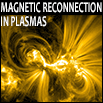Speaker
Dr
Rumi Nakamura
(IWF/OEAW)
Description
In the Earth's magnetotail, there are two preferred sites for the
magnetic
reconnection. One is in the distant tail usually beyond the lunar orbit,
and is
considered to be semi-permanently present. The other is in the near
tail at a
distance of a few tens of Earth radius (Re), where the magnetic
reconnection initially
involves closed-field lines in the plasma sheet and hence affected
strongly by
internal processes in addition to the external drivers. Important
consequence of the
magnetotail reconnection is the narrow fast plasma jets (known as
bursty bulk
flows), which provide the major contribution to energy and mass
transport in the
magnetotail. Interaction with the reconnection jets moving Earthward
and the
Earth's dipole field lead to acceleration of particles, formation of the
field-aligned
current system, and associated auroral precipitation, and modifies the
near-Earth
field configuration. In this way the near-Earth's magnetotail
reconnection has also
large-scale consequences as manifested during substorms.
This presentation high-lights observations of the thin current sheets
during near-
Earth's magnetotail reconnection and the reconnection jet evolution
obtained from
multi-point measurements by Cluster and THEMIS and addresses
expected
observations with the newly launched MMS. Depending on the
spacecraft
configuration, processes relevant to reconnection with different
spatial/temporal
scales have been observed by the spacecraft. Characteristics of the
Hall-current in
the ion diffusion region and a 3D nature of the localized magnetic
structures in the
reconnection region without guide field and with guide field are
presented. Larger
scale processes associated with the braking of the fast flow in the near
Earth
magnetosphere and formation of thin-current sheet that leads to onset
of
reconnection will be also discussed.
Primary author
Dr
Rumi Nakamura
(IWF/OEAW)

